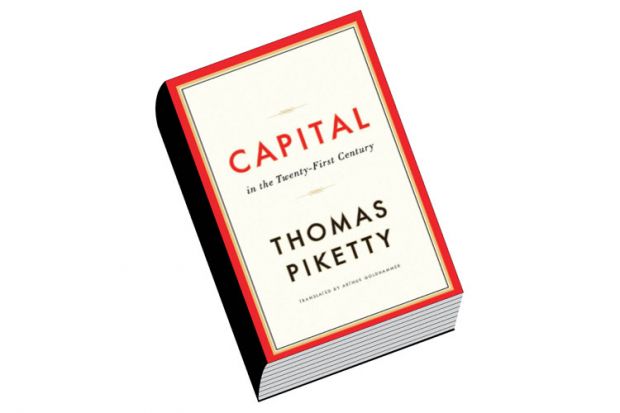As everyone who works with data knows, the answer to a question depends on where you start and stop counting. Thomas Piketty’s magisterial and much-hyped tome begins at the beginning (in antiquity) and ends in the not-so-distant future, at the end of the 21st century. Taking in the whole of time and beyond, he offers the staid Anglo-Saxon reader a dreamy combination: exotic, foreign intellectualism, grand theoretical ambition but an ultimately simple message (r>g, no less), and mountains and mountains of data. Small wonder it has taken the anglophone world by storm.
Piketty, professor at the Paris School of Economics and director of studies at the École des Hautes Études en Sciences Sociales, has laboured for years to update the Kuznets Curve, a 1950s vision of the end of inequality in free market America, and to bring the study of the distribution of wealth into the present and beyond.
He argues that Simon Kuznets’ post-war optimism was misplaced, and that the real narrative, the long view, is one in which capital is as powerful at the beginning of the 21st century as it was 100 years earlier. What might have looked like an irreversible trend towards greater equality at the height of the Cold War was merely a blip in capital’s history of dominance.
Central to his narrative is the “tendency” for the rate of return on capital to outstrip the rate of growth, a gnomic utterance that needs a bit of unpicking. Growth is the only source of returns, so what matters must be the division of spoils; if returns to capital are higher, capital must be taking the lion’s share of growth. Piketty shows us that throughout history, capital managed to do just that. His radical contribution is the claim that the rampant growth and low returns of the 20th century, a combination that lowered inequality, were not the beginning of a new history but a temporary exception to the old. They resulted from a very particular combination of social upheavals, not least the Great Depression, two world wars and the collapse of European empire. Thanks to the rise of the “super-manager” in the US and slowing growth in Europe and elsewhere, the 21st century looks set to be as unequal, if not more so, as the 19th. (He has some very bad news for the middle classes, by the way, but I’ll leave that discovery to the reader.) Piketty’s recurrent analogy is drawn not from novels set in the future, but the classics of the 19th century, from Jane Austen and Honoré de Balzac and their preoccupation with inherited wealth.
Such historical awareness is one of the hallmarks of the book, although Piketty can be sloppy with his examples: I’m not sure that Quentin Tarantino’s film Django Unchained or Disney’s animated feature The Aristocats count as reliable sources. But in a book as grandiose and bursting with ideas as this, we can forgive the occasional loose analogy. Indeed, it is the element of mischief that makes this massive work readable. Piketty the man, political and opinionated, is ever-present, always willing to take amusing swipes at the grandees of textbook economics. When he says of Pareto’s equilibria of stable inequality, “Of course the Fascists would naturally have been attracted to Pareto’s theory”, what he thinks of anyone foolish enough to use it now (ie, everybody) is clear enough.
Piketty is keen that we do not take any social arrangement or pattern of distribution as natural. Tendency and equilibrium do not mean immovable stasis. He repeatedly reminds us that the 19th century’s supremacy of capital was as much a social construction as the egalitarian boom of the 20th. He urges us to work for change, with redistributive measures in the shape of a global tax on wealth and a social state worthy of our time, difficult though that might be.
But for all its strengths, there is a peculiar asymmetry at the heart of this book. Piketty has a weakness for grandiose phrases: “capital is never quiet…it always tends to transform itself into rents…that is its vocation, its logical destination”. We see a shadow of Karl Marx, but Piketty keeps it silent. He gives a detailed explanation for the collapse of returns in the inter-war period, yet when it comes to the astonishing stability of rents for the rest of history he is mute. For me, this is the question of questions. Why do capital returns always outstrip growth? What drives this “tendency” and “dynamic process”?
Capital wins out, says Piketty, because it can do so many other things. Indeed it can. It can invest in technology, but this is a weak argument. There is no reason why returns from enhanced productivity should not be shared. Piketty is well aware of capital’s other habits: lobbying, changing the law, enclosing intellectual property, hiring private security forces, expropriating labour and conjuring financial instruments out of thin air. The list is as long as imagination itself, for capital is truly entrepreneurial. Where Marx gave us a detailed, if flawed, explanation of how capital enriches itself at the expense of labour, Piketty offers no such thing. This book is economics at its best, and still we are short of an answer.
Philip Roscoe is reader in management, University of St Andrews, and author of I Spend, Therefore I Am: The True Cost of Economics (2014).
Capital in the Twenty-First Century
By Thomas Piketty, translated by Arthur Goldhammer
Harvard University Press, 696pp, £29.95
ISBN 9780674430006
Published 30 April 2014




